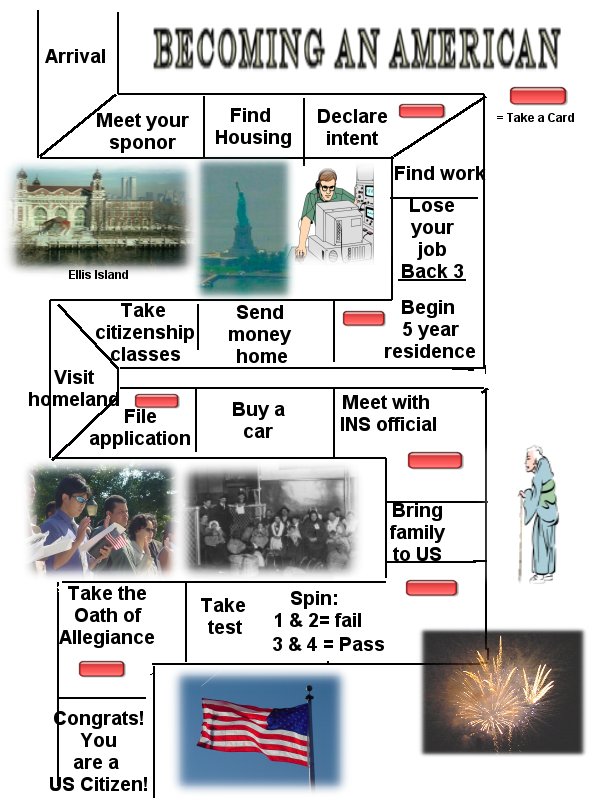 |
|The Naturalization Game: An Example of Visual Language in Social Studies
The Graduate Manifesto of George Cassutto
Social Studies Education in the 21st Century
Teaching Social Studies in the traditional classroom in the digital video age forces teachers to create lessons that reflect the interests and learning styles of their students. These Net-Gen students have shortened attention spans, a lower tolerance for the written word, and are more motivated by interactive and stimulating activities. Oddly, I have found young adolescents still react positively to the classroom discussion format for exactly that reason: it is interactive, and it gives students a voice without having to expend the energy to read a textbook or write an essay.
| If classroom teachers want to bring cooperative learning into their lesson formats, that's fine, but they appear to be more effective after the class has devoted some time to "team-building" and "class-building" activities that give the class a feeling of community and the students a bond with each other and with their teacher. Large chunks of classroom time are not devoted to Social Studies content but to the affective aspect of working in groups. Much time is devoted to helping students "feel good" about themselves as learners and about their classmates and teachers. |
|
The History Alive! model does help make some of these challenges easier for today's Social Studies teachers. Even though I teach Government to eighth graders, the model can be adapted to make Civics a more compelling subject, especially for students who are not verbal or visual learners. Social Studies is a predominantly verbal subject. I tell my students that having a good command of the English language is half the battle in understanding Civics concepts. Much of our background building is mastering the vocabulary of a given topic. But not everyone is linguistically gifted. In our class we learned how to communicate our basic information by way of visual language. Placing the written word along side symbols and using these in conjunction with each other can help students who may not be effective learners with the written word alone (Horn, pg 233).
The web is a rich resource in developing visual data that can be used in class because teachers can do searched at the Google search engine for images they can incorporate into their lessons. They can create "interactive slide lectures" that help students visualize the information they must master. This requires teachers to be effective searchers and to become effective graphic artists. They need to know how to import images, combine them, create their own images, use digital photography, and they need to be able to combine text and images wisely either in static form or in PowerPoint presentations. Here is one example of how graphics software can be used to enhance instruction. I created a game where students had to draw cards that moved them through the naturalization process as an immigrant would do on his or her way to citizenship. Four of the interior images were taken by myself with a digital camera. Other elements are from the web or clip art galleries. The game board can be projected by PC and LCD or transferred to overhead transparency, preferably by way of color laser printer.
 |
|
The Naturalization Game: An Example of Visual Language in Social Studies
The visual medium is well communicated by the graphic organizer. To create graphic organizers that teachers and students can use, the software called Inspiration is a great help. Teachers can use it to relay an outline or set of data, (the link at left will reveal a flow chart on the causes of genocide) and students can use it to show their mastery of a topic or for pre-writing when getting set to compose an essay. Students can add notes to each element they bring into the graphic organizer. This way, curriculum designers can use Inspiration as a prompt for student research.
| It is important that web course designers and mentors understand the value of visual language when delivering course content. On-line learners get their information from the screen, a medium that combines visual, verbal, kinesthetic, and auditory learning. Visual language can be used to summarize a chapter or modular unit of learning. It can be used to organize complex data into a coherent gestalt for students to digest. Visual language helps students focus on what's important and discern what can be subordinated for later consumption or not at all. It helps students move from the concrete to the abstract, which can be helpful for students who still need to master more complex thinking skills (Horn, 1998). |
|
It is a combination of informational media that can be transmitted over the web or brought into the brick-and-mortar classroom with the effect of enhancing instruction and comprehension.